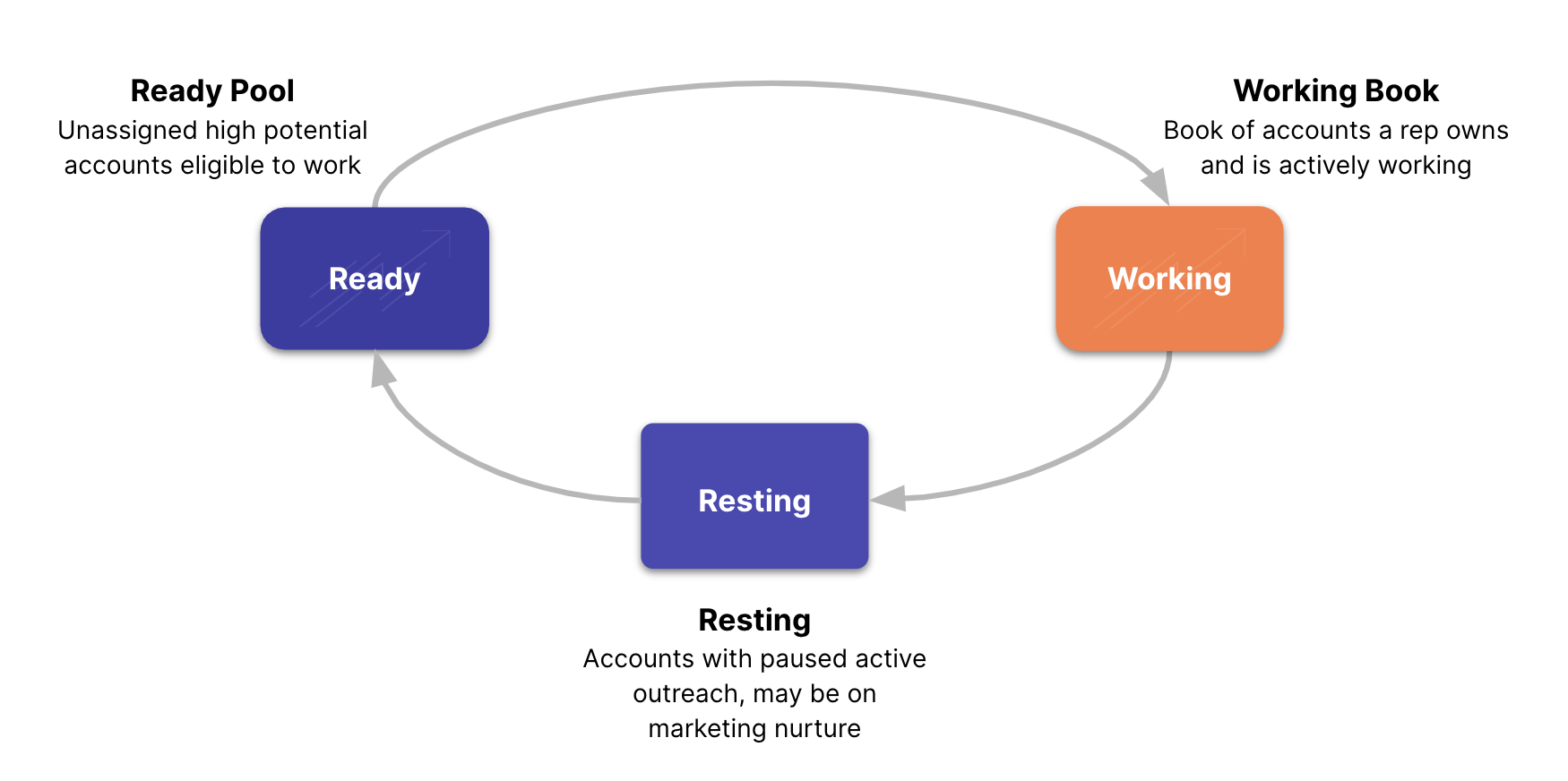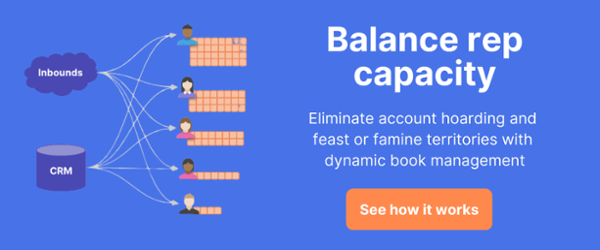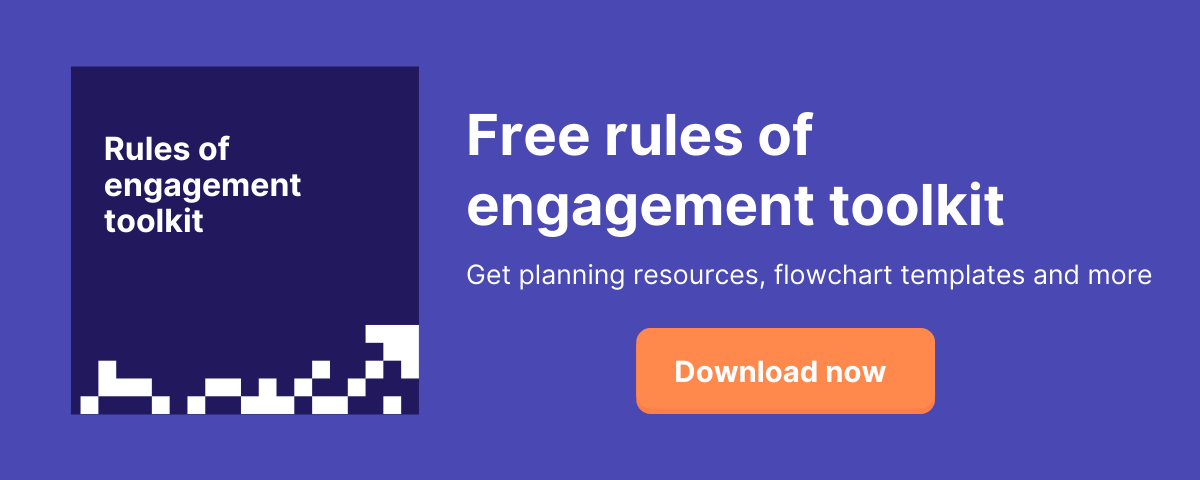Let's talk about account retrievals and redistributions - cycling the accounts that a rep owns at a given time. It's kind of a "use it or lose it" policy, but it's not meant as a carrot or stick for reps. It's a way of ensuring every account gets the attention it needs.
Retrieval and redistribution involves working accounts for a set amount of time, then disqualifying them or sending them back into a pool to rest for other reasons, and getting new accounts to replace the ones that are DQed or resting. It's a dynamic process that makes sure unworked high-potential accounts don’t stay locked up in a rep’s book, growing dusty or being scooped up by a competitor. Ultimately, this means you're fully working all the accounts in your TAM and increasing your chances of increasing attainment.
So let's talk more about the retrieval and redistribution process. You may have heard this process called "reap and replace" or "use it or lose it" or maybe you've never heard it called anything at all. We'll just use R&R in some places for simplicity.
What is retrieval and redistribution?
The basic idea behind retrievals and redistribution is that you implement a dynamic process that ensures a rep only owns accounts they're actively working, and accounts are moved into and out of a rep's name as they demonstrate intent and go cold, respectively. A rep has to be working an account to keep it. When they're done working it (it's disqualified, non-responsive, etc...) or if they simply stop working it, it goes back into the pool until it's time to work it again. This way, reps' book are constantly refreshed, and every rep can focus on the highest priority accounts.
This usually happens on an outbound SDR team, or with full-cycle AEs who do their own prospecting. It can be used alongside a traditional territory model, but you usually see it in more dynamic organizations where reps aren't limited to prospecting in one specific area.
Imagine this scenario. Instead of a fixed list of accounts, reps are assigned a target book, which defines the types of accounts they’re responsible for working. For example, a mid-market SDR is responsible for working 100 accounts with between $50MM and $500MM in annual revenue. When that rep starts, the best available accounts in the pool that meet the mid-market criteria would be distributed to them. As they work those accounts, they may learn that some are disqualified because they are with a competitor or have undergone M&A. When they learn this, they can return the account to the pool and a new mid-market account is distributed to them. They are responsible for actively working each account in their book. If they stop working an account, it will be retrieved from them and placed back in the pool for future distribution.
That's an example of retrieve and redistribute. Let's start by getting on the same page with a few key terms.
Definitions
- Pool: A group of accounts that are unassigned and available to be worked
- Book: A group of accounts currently owned (and being worked) by a rep
- Distribution: Sending one or more unworked accounts to a rep to be worked
- Return: A rep sends a fully worked and disqualified account back to the pool
- Retrieval: An automated return of accounts that are not actively being worked to the pool
- Signals: Fit and timing criteria that indicate whether or not an account is high potential or high intent
- Working: An account is being "worked" when a rep is actively engaging (or at least actively trying to engage) with a prospect. An account is no longer being worked after some period of time after the last meaningful activity.
- Rest: A period of time when an account sits unworked in the pool before it is eligible to be worked again

There are a few things you need to think about when implementing a retrieval and redistribution process.
1. Define clear rules of engagement and SLAs for reps
Since you’re going to be retrieving accounts from reps that aren’t actively worked, you need to establish a clear set of rules for what counts as working an account. This needs to be something that’s objective, measurable, and can be defined in Salesforce. If this is unclear in any way, it will seem (and may actually be) unfair to reps.
Typically an account is no longer being worked if it's been some amount of time since the last meaningful activity. Depending on your sales cycle, it will likely be 15 to 90 days after the last meaningful activity before an account is considered no longer being worked. Whatever you decide on, write it down, communicate it to your reps, and evaluate it after a few months.
You also need to decide how many accounts should be in a rep's name at once. Your ideal book size will vary depending on sales cycle length, ACV, average touches needed, the number of contacts per account, and so many more factors. You may have different target book sizes for different segments or products. We have a handy little calculator that may help you decide here.
2. Update your team's mental model of account ownership
You may worry about how your team will feel about implementing an R&R process. It's a big change for some teams. Instead of reps owning a territory or large number of statically assigned accounts, reps will now only own accounts they’re actively working. Accounts that reps aren’t actively engaged with are kept in a pool for marketing nurture or future engagement. So reps need to work accounts to keep them.
You may need to address issues of account hoarding, and rep concerns about quota and compensation. Stress that while they may not have as many accounts in their name at one time, they will have higher quality accounts that have higher potential to convert. They won't need to spend time figuring out which accounts to work. And once an account is proven to be disqualified, they'll get a new account in its place. So they'll likely get more accounts over time, since new ones will be moving out to replace old ones. And they'll be more likely to hit quota this way.
This actually may end up helping with your CRM hygiene too - if a rep has to demonstrate that they're working an account so they can keep it, they'll have to update Salesforce!
3. Select your fit and timing signals
What makes an account high potential? How do you decide that an account in your pool is ready to work and should be distributed to a rep? You need to look for fit and timing signals.
Fit. You're looking for criteria that indicate ICP fit. You may already use a simple scoring methodology here. Start with that. Simple is better anyway - some people try to get too fancy with their score, and it becomes overly complex and is likely more than you need to get started. Start small, work up to sophisticated.
Timing. Determine which indicators you have to tell you that an account is ready for your solution. Which of those indicators would cause you to want to ensure the account is assigned to rep? Put another way, what would indicate a missed opportunity that you’d kick yourself about later? It might be a funding announcement, an upcoming contract expiration, a new executive hire, and so on. You may have an ABM product that tells you something about intent or buying stage, and that's likely a timing signal. Another big timing signal is a hand raise, like a demo request. What role do inbound leads play in your account pool?
We've written lots more about fit and timing if you want to go deeper on these.
4. Monitor, measure, and reevaluate.
Keep an eye on how things are going. Look at things you can measure, like the size of reps' account books (How many accounts do they own now? Are accounts evenly distributed across your team?), activity (# of calls, emails, accounts touched), and changes to success metrics (meetings set, opps created, pipeline, and so on). But also talk to your reps and managers to understand how this is working in practice. How do they feel about it? Do they have enough to do? Do they have too much? Are the accounts they've actively working the right accounts? Are you giving accounts enough time to be worked fully? Don't be afraid to tweak your process as you go, to make sure everyone has the best opportunity to succeed.
Have you implemented a retrievals model on your sales team? We'd love to hear more about it. Find us on LinkedIn and let us know!








